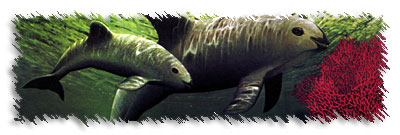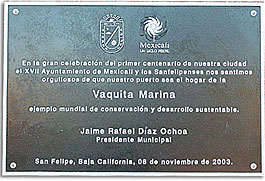They look like tiny Ninja whales,
cloaked in shadows and wearing dark masks. They are Phocoena
sinus, the Gulf of California harbor porpoise or
vaquita marina.
The vaquita has the most limited
distribution of any cetacean and is found exclusively
in the northern Sea of Cortez. Scientists were only recently
introduced to this specie. In 1958 three vaquita skulls
were found on the beaches near San Felipe. By 1980, with
the help of Centro de Estudios de Desiertos Y Océanos
(CEDO) at Puerto Peñasco, the number of whole specimens
recovered numbered five. Since then, because of more modern
fishing techniques, the mortally rate of this beautiful
creature has grown alarmingly.
 The
vaquita is the smallest of all cetaceans, measuring four
to five feet when fully grown and weighing about 120 lbs.
Females tend to be a little larger than the males. They
are seldom seen on the surface of the water. Sightings
are rare, being more a reward for the diligent field biologist
than a gift to the camera-carrying tourist. There are
only an estimated 200 to 800 vaquitas remaining and it's
been suggested the population is declining by as much
as 20 percent per annum. Vaquitas are not intentionally
hunted but at least 25 a year are entangled and die in
fishing nets set for other species. Totoaba, another
endangered specie, was officially protected by a ban in
1975. But fishermen in places like El Golfo, Sonora and
San Felipe largely ignored the ban. It was their 10 and
12 inch diameter mesh gillnets that often captured and
drowned vaquitas. The
vaquita is the smallest of all cetaceans, measuring four
to five feet when fully grown and weighing about 120 lbs.
Females tend to be a little larger than the males. They
are seldom seen on the surface of the water. Sightings
are rare, being more a reward for the diligent field biologist
than a gift to the camera-carrying tourist. There are
only an estimated 200 to 800 vaquitas remaining and it's
been suggested the population is declining by as much
as 20 percent per annum. Vaquitas are not intentionally
hunted but at least 25 a year are entangled and die in
fishing nets set for other species. Totoaba, another
endangered specie, was officially protected by a ban in
1975. But fishermen in places like El Golfo, Sonora and
San Felipe largely ignored the ban. It was their 10 and
12 inch diameter mesh gillnets that often captured and
drowned vaquitas.
San Felipe is part of the Upper
Gulf Biosphere Reserve, which is designed to protect vaquitas
as well as other depleted species. However, 40% of the
vaquitas range outside of the Reserve's protection. And
"reserve" designation has not restricted gill
net fisheries.
In 1996 the Mexican government established
the International Committee for the Recovery of the Vaquita
(CIRVA). Its first act was to estimate the existing population
of the vaquita at 567. Then an analysis was done on the
various factors affecting vaquita mortality and it was
determined that incidental fisheries fatalities (ie: net
entanglement) were the greatest immediate threat to the
specie. CIRVA studied available data on the vaquita, fishing
activities and zones. They made recommendation for the
recuperation of the vaquita specie that included eliminating
vaquita by-catch as soon as possible, extend the southern
boundary of the Reserve to encompass the entire range
of the vaquita and to ban gill-netting and trawlers in
the enlarged Reserve.
Unfortunately a ban on gill netting
and trawlers in the upper Gulf would leave no alternatives
to many fishing-dependent families in the area. CEDO held
workshops with fishermen from the three principle fishing
communities --El Golfo, San Felipe and Puerto Peñasco,
sharing scientific data on the vaquita, polling them about
their willingness to change their fishing techniques or
explore other avenues to ensure their livelihood. A majority
of the fishermen seemed willing to change the way they
fished.
CIRVA is now active in bringing
about legal changes that will more rapidly ensure the
vaquita's protection and expand the size of the Reserve.
 Plaque reflecting San Felipe's
commitment
Plaque reflecting San Felipe's
commitment
to preserving the vaquita marina. |
On the other hand a statement published
in November of 2001 by the Camara Nacional de la Industria
Pesquera (CANAINPES) of Puerto Penasco showed less
commitment to the agenda of the Reserve. They complained
that the curtailing of their shrimping grounds was too
sudden, that they did not receive sufficient notice before
the prohibitions of the Protected Area was ratified. They
cited their heritage as fishermen and sons of fishermen,
implying a right to shrimp anywhere they chose. When it
became apparent the Biosphere protection would be enforced,
they asked for permission to shrimp in the prohibited
zone from October through mid-January, citing the illegal
and unpunished activities of San Felipe and El Golfo fishermen
as precedent.
According to a report by the United
Nations Food and Agriculture Organization (FAO), "about
70 percent of the world's marine fish stocks are fully
to heavily exploited, overexploited, depleted or slowly
recovering." Although this situation is clearly unsustainable,
the commercial fishing industry appears to be doing little
to mend its ways.
Reporter Tom Knudson of the Sacramento
Bee explained the problem of free market environmentalism.
"Fishing is supposed to be done conservatively to
protect stocks," he wrote. "But in poverty-stricken
Mexico, another rule applies: If you will buy it, they
will kill it. They will liquidate their sea."
The vaquita marinas' future is in doubt.
Some steps are being taken by both Mexico and the United
States to prevent their extinction. But these steps may
be too little too late against tradition that never questions
itself or the ultimate results of its actions.
Below are some links to more information
about the vaquita marina.
|